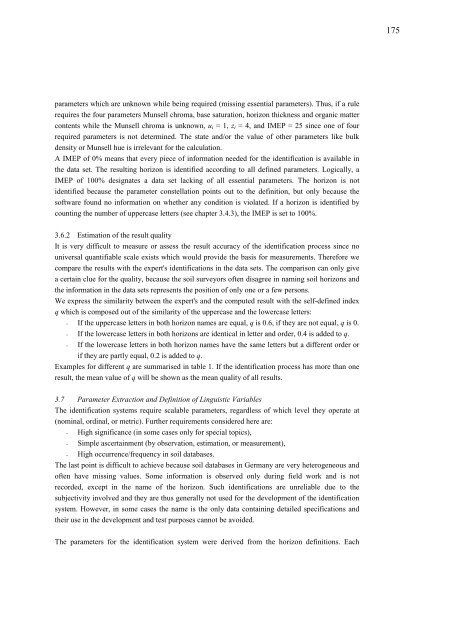Rechnergestützte Identifikation von Böden - OPUS Bayreuth ...
Rechnergestützte Identifikation von Böden - OPUS Bayreuth ...
Rechnergestützte Identifikation von Böden - OPUS Bayreuth ...
Sie wollen auch ein ePaper? Erhöhen Sie die Reichweite Ihrer Titel.
YUMPU macht aus Druck-PDFs automatisch weboptimierte ePaper, die Google liebt.
175<br />
parameters which are unknown while being required (missing essential parameters). Thus, if a rule<br />
requires the four parameters Munsell chroma, base saturation, horizon thickness and organic matter<br />
contents while the Munsell chroma is unknown, u i = 1, z i = 4, and IMEP = 25 since one of four<br />
required parameters is not determined. The state and/or the value of other parameters like bulk<br />
density or Munsell hue is irrelevant for the calculation.<br />
A IMEP of 0% means that every piece of information needed for the identification is available in<br />
the data set. The resulting horizon is identified according to all defined parameters. Logically, a<br />
IMEP of 100% designates a data set lacking of all essential parameters. The horizon is not<br />
identified because the parameter constellation points out to the definition, but only because the<br />
software found no information on whether any condition is violated. If a horizon is identified by<br />
counting the number of uppercase letters (see chapter 3.4.3), the IMEP is set to 100%.<br />
3.6.2 Estimation of the result quality<br />
It is very difficult to measure or assess the result accuracy of the identification process since no<br />
universal quantifiable scale exists which would provide the basis for measurements. Therefore we<br />
compare the results with the expert's identifications in the data sets. The comparison can only give<br />
a certain clue for the quality, because the soil surveyors often disagree in naming soil horizons and<br />
the information in the data sets represents the position of only one or a few persons.<br />
We express the similarity between the expert's and the computed result with the self-defined index<br />
q which is composed out of the similarity of the uppercase and the lowercase letters:<br />
- If the uppercase letters in both horizon names are equal, q is 0.6, if they are not equal, q is 0.<br />
- If the lowercase letters in both horizons are identical in letter and order, 0.4 is added to q.<br />
- If the lowercase letters in both horizon names have the same letters but a different order or<br />
if they are partly equal, 0.2 is added to q.<br />
Examples for different q are summarised in table 1. If the identification process has more than one<br />
result, the mean value of q will be shown as the mean quality of all results.<br />
3.7 Parameter Extraction and Definition of Linguistic Variables<br />
The identification systems require scalable parameters, regardless of which level they operate at<br />
(nominal, ordinal, or metric). Further requirements considered here are:<br />
- High significance (in some cases only for special topics),<br />
- Simple ascertainment (by observation, estimation, or measurement),<br />
- High occurrence/frequency in soil databases.<br />
The last point is difficult to achieve because soil databases in Germany are very heterogeneous and<br />
often have missing values. Some information is observed only during field work and is not<br />
recorded, except in the name of the horizon. Such identifications are unreliable due to the<br />
subjectivity involved and they are thus generally not used for the development of the identification<br />
system. However, in some cases the name is the only data containing detailed specifications and<br />
their use in the development and test purposes cannot be avoided.<br />
The parameters for the identification system were derived from the horizon definitions. Each
















